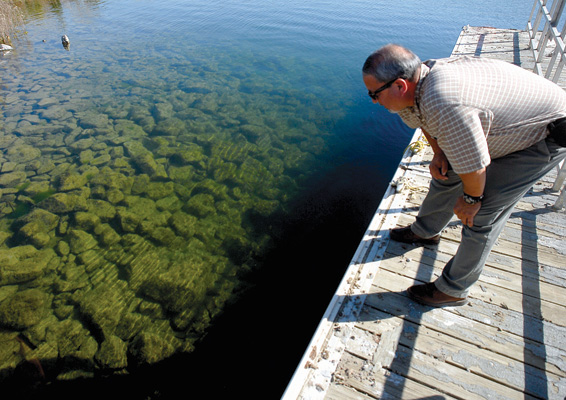
San Justo Reservoir remains closed indefinitely as various state
and federal agencies plan to lower the level of water and treat it
with a chemical to eradicate invasive zebra mussels found earlier
this year.
San Justo Reservoir remains closed indefinitely as various state and federal agencies plan to lower the level of water and treat it with a chemical to eradicate invasive zebra mussels found earlier this year.
Officials will add potassium chloride, or “potash,” to the water in late summer 2009, which means local farmers can start planning now, according to Michael Jackson of the federal Bureau of Reclamation.
“It will be lowered, and that will mean less water – not lowering the reservoir would create additional challenges in terms of treatment and viability of success in the abatement of the zebra mussel,” Jackson said.
But Harry Blohm, the program manager for the San Benito County Water District’s special projects, said that effect on local agriculture will be minimized.
“Insofar as we can, we will time the drawdown for the least impact on farmers,” said Blohm, who underscored the district’s commitment to “work very hard to minimize impact.”
“We have a sophisticated hydrological model that will show the effects to the entire water system,” continued Blohm, who indicated that the model will allow his department to select the best time and method of drawdown to eradicate the zebra mussel and provide sufficient water to local agriculture.
Zebra mussels are invasive shellfish that can clog water pumps and pipes and potentially cause major disruptions throughout the region and potentially the state, as San Justo is connected to the Central Valley water system. Experts have concluded the species hasn’t spread outside the local reservoir and part of their focus at San Justo – since it was the first zebra mussel discovery in California – has been to learn how the species responds to warmer waters to prevent further infestation here.
Since the outbreak, officials at the Santa Clara Valley Water District – which serves Gilroy and Morgan Hill – have continually monitored all 10 of the county’s reservoirs, but no zebra mussels have turned up yet, according to District Spokeswoman Susan Siravo.
“There’s nothing to indicate that there are zebra mussels in the (Santa Clara County) water supply,” Siravo said.
For a few weeks after the outbreak, the district stopped bringing water from the San Luis Reservoir to the Calera and Anderson reservoirs, but that transfer resumed shortly thereafter because it posed no danger, Siravo added. And, in May the district launched a vessel inspection program at Anderson, Calero and Chesbro reservoirs.
The California Department of Fish and Game initially confirmed Jan. 15 that San Justo Reservoir had been the first ever California water body infested by the zebra mussel. Officials zeroed in on potash for treatment because it is viewed as the least toxic alternative to rid the mussel species. Jackson noted how potash was used successfully to eradicate zebra mussels in Virginia at a quarry named Millbrook.
The project description, on which officials are working, is the “critical piece” toward starting the treatment’s environmental review, said San Benito County Water District Manager Jeff Cattaneo.
Since this is the first infestation this far west, she said it’s important to understand how these shellfish respond to warmer waters.
All of this research, according to Retallack, will be useful in allowing the agencies to learn how to “prevent future infestations and eliminate the species from the state.”
“It is a serious threat to California waters,” she said. “If they go unchecked, they will clog everything from the intake system of a reservoir to the sprinkler heads in the fields.”
Retallack, however, also said it’s important to consider the impact to local water supplies. “We have to have a healthy respect for water distribution – any drawdown for the application of potash can’t waste water.”









